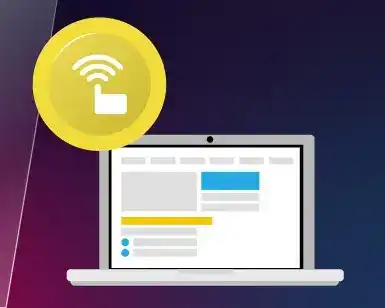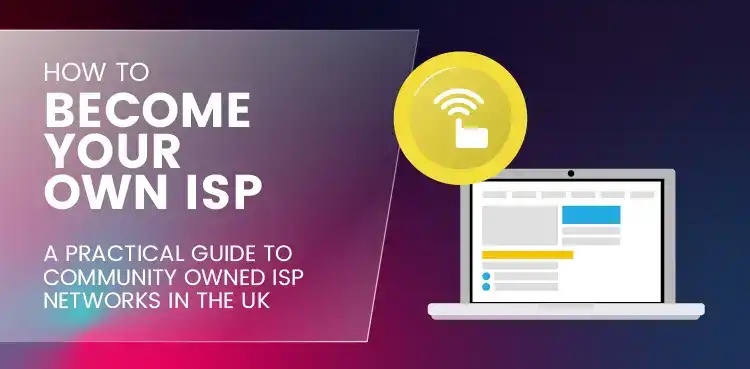
How to Become Your Own ISP - A Practical Guide to Community Owned ISP Networks in the UK
Internet service providers (ISPs for short) are companies that provide customers with internet access. ISPs make the internet easy; all you need to do is buy a connection from the best provider available and then attach any devices needing an internet connection to said provider’s network. However, what is the price we pay for this convenience? Too often poor services and speeds are offered at high prices, leading to widespread discontent among Britons.
An alternative to reliance on large ISPs is building a neighbourhood, community, or even personally owned infrastructure. The advantages which this option offers are, in general terms, twofold:
+ Greater internet connectivity speed;
+ Lower prices than those offered by existing ISPs.
Let’s first dispense with the notion that this is just a project which far-flung, secluded, rural areas can benefit from – far from it. In fact, notwithstanding the UK’s jump from 35th to 34th place in the 2019 Worldwide Global Broadband Speed League Table, Brits will be cognisant of the fact that their country lags behind two thirds of EU states, as well as countries such as Madagascar or Malaysia.
Furthermore, with the broader research used to compile the ranking revealing that other EU member countries are far ahead in terms of rolling out FTTP, the UK can expect to slip in rankings next year. The country will need to invest heavily in FTTH coverage, especially in rural areas, in order to prevent an even sharper fall in the coming years.
Bearing these statistics in mind, but also in light of the day-to-day realities surrounding UK broadband infrastructure and services, perhaps now is the best time to learn how to become your own ISP.
How to Become an ISP in the UK
1: ISP or WISP - Assess your area
2: Sort out funding and paperwork
3: Find a fibre provider
4: Build your infrastructure
5: Connect to customers & make plans for network maintenance
Across the pond, the importance of community-owned networks has been recognised for a while. A recent Harvard University study revealed that because community-owned ISPs charged less and offered prices which were unambiguous and unchanging, they were driving competition in the larger ISP market, leading to improved overall services across the board.
Other major advantages stem from the fact community-owned ISPs will have a smaller customer base which they will be able to service more efficiently, as well as from the lower down-time experienced following emergency situations.
A Bit of Internet Infrastructure Background:
We'll first need to provide some contextual information on how the internet works. Data centres containing physical servers with huge amounts of hard disk storage stock all the information on the internet.
These centres transmit signals by way of a fibre infrastructure running through a huge network of cables, mostly located underneath the ocean beds of our planet.
This fibre infrastructure has exchange points throughout the world which ISPs tap into in order to exchange information. From there, ISPs build facilities which allow them to share the signal with consumers. This is where community-owned ISPs come in to provide better connectivity solutions for certain areas.

Photo credit: Anteromite/Shutterstock
Step 1: ISP or WISP - Assess your area
The first step is figuring out what sort of connection infrastructure would best suit your area and your needs.
There are two main options which are available to a community wanting to become their own ISP:
+ Wired network (ISP)
+ Wireless network (WISP)
Wired networks
These networks make use of fibre in order to relay signal from a central fibre infrastructure to a local hub (and then to each consumer) or directly from the central fibre infrastructure to individual users.
The main ways through which ISPs provide broadband to customers are:
+ FTTC
Fibre is installed to a cabinet which is then connected to the individual premises using the existing copper line. These types of connections can handle a maximum of 80 megabits per second. However, the main problem is that the further away the premises are from the cabinet, the slower the connection becomes.
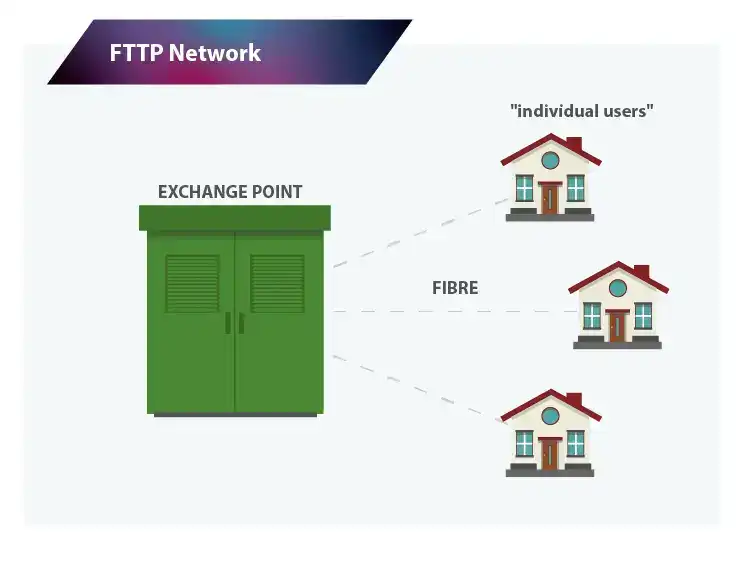
+ FTTP
Fibre is run directly from the exchange point to each premises, allowing for high broadband speeds of up to 1 gigabit per second. This connection is future proof and also provides high upload speeds, which is especially beneficial for those working from home or for businesses.
In order to make the investment worth it, most communities will want to opt for FTTP connections.
Rural communities will be much better served by wired networks than urban groups. This is because installing fibre networks in cities is much more difficult and costly – more on this in Step 2.
Wireless networks
Wireless networks are the cheaper option since they require less investment in physical infrastructure.
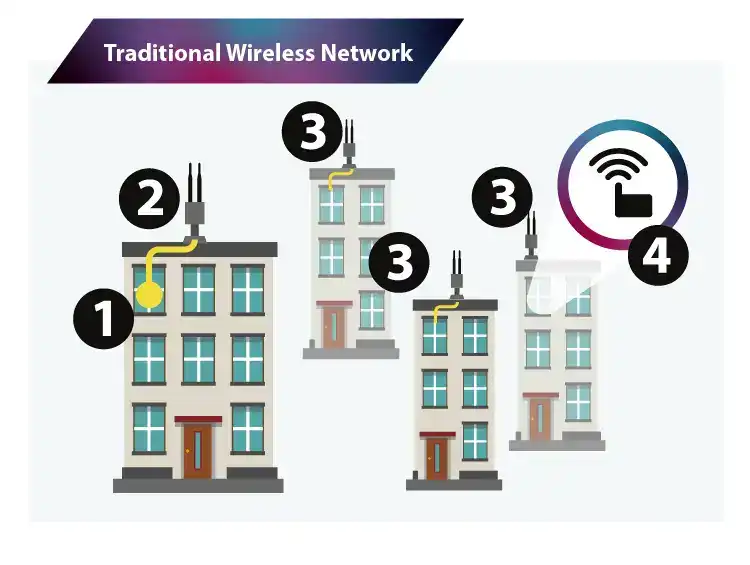
- internet connection
- omnidirectional antenna transmitting wireless signal to area around the building
- receiver dishes attached to each user's premises
- small access point distributing wireless network inside the client's building
Traditional WiFi Networks
In traditional WiFi networks, a single router is used to spread the incoming wired signal from a main hub to each individual user. This causes the power of the signal to decay as it travels through the air, making the network inefficient in terms of providing high speeds in a large area.
Those wishing to establish a wireless community network will need to construct a fixed wireless broadband infrastructure. Such an infrastructure starts from a central hub. This hub should be a tall building, one from which all of the individual premises which will be part of the network must be seen with the naked eye. The central hub is the only premises in the network which is physically connected to the closest access point through a Fibre Demarcation Point (aka a ‘hand-off’ from the service provider).
A router connected to a wireless transmitter (or antenna) is installed on the main hub’s rooftop in order to broadcast the WiFi signal to individual households.
In order for the signal to then reach individual consumers, a receiver dish is attached to each user’s premises. In community led projects these are usually bought by the user, though they can also be rented from the ISP.
These types of WiFi networks will not fare well in areas characterised by steep hills or tall trees. This is because the strength of the signal will degrade as it passes through objects. It might still be possible to establish a wireless network if there are lots of trees in the area. However, as they grow taller the network might become unusable due to signal decay. Furthermore, those in urban areas with a variety of both tall and shorter buildings will find it difficult to create wireless networks due to this limitation. It might still be possible if you manage to rent rooftop space on a structure that has unobstructed views of the premises in your network.
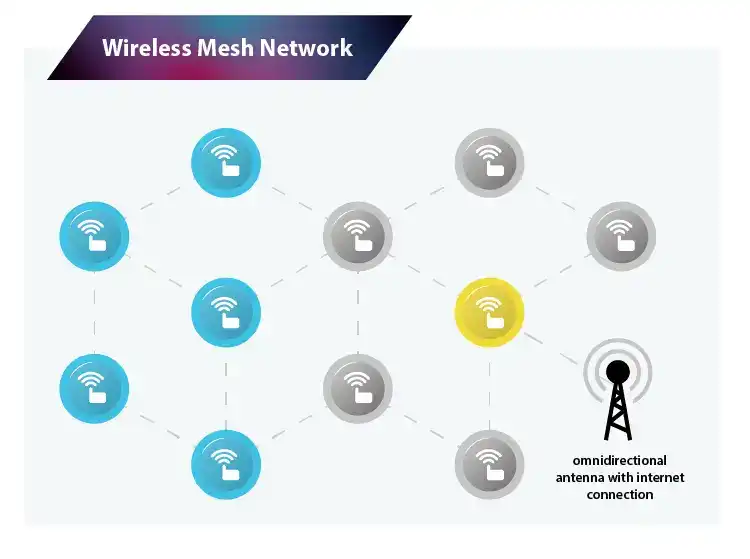
Mesh Networks
Mesh networks are characterised by a series of nodes (aka connection points) which are able to communicate with one another, spreading the signal from one to the other. The ability to spread the signal in this way is what separates mesh networks from traditional WiFi networks.
We have discussed how traditional WiFi networks work and how this modus operandi brings about limitations in how far the signal can reach. Mesh networks bypass this critical deficit by allowing each node to relay the WiFi signal coming from the head node (aka the modem) without losing much speed in the process.
This network topology is used on a smaller scale in many offices, where a central router is connected to the external internet through a wired connection while also sharing this connection with many other satellite routers distributed throughout the office.
By using mesh network technology (which is supplied by a number of companies including US-based Althea and UK-based LocustWorld) users can pool their money together and purchase a commercial grade internet connection. This bandwidth can then be distributed through the local mesh, providing a much cheaper connection. The decentralised nature of the network goes one step further: there is no need for a subscription. Routers are able to pay each other using cryptocurrency. Thus, all that is needed apart from the router itself is a long-range WiFi antenna, making it possible for users to use cryptocurrency on a pay-as-you-go basis.
The best part is that as the signal makes small jumps from device to device, it isn’t affected by decay. Moreover, because of their decentralised nature, they can scale practically without limit, maintaining the ability to send and receive data at the same pace.
Make Use of Existing Infrastructure
Before beginning the process of becoming yout own ISP, you should use the fibre checker to see if there are currently plans to bring fibre to your area. If there are no plans of this sort, then a community broadband project is in order.
In deciding which community broadband option is best for you, you should find out:
+ what exchange points and/or cabinets serve the area;
+ what types of services are made available by the exchange points;
+ how long the lines are which connect the premises to either the cabinet or the exchange point.
In order to find out the status of your area’s service availability, it’s worth checking if local bodies have already conducted mapping and public consultation exercises. If so, all the information needed will be readily available and you can plan accordingly.
The already existing infrastructure should serve as a starting point for all community broadband projects.
Step 2: Sort out funding and paperwork
Funding
What sort of investment is needed will hinge on what your initial prospecting phase has revealed and on what connectivity option you have chosen.
Depending on the size and nature of your project you might need either public or private funding, if not a combination of both.
Private Fund-Raising
The logical starting point for a community-led project such as this would be a private fund-raising strategy involving all those who have expressed their interest in the undertaking. You can use:
+ Crowd funding platforms
Local residents and businesses will most likely be willing to make donations in order to fund the community broadband project and the funds can be pooled using a crowdfunding platform.
Other parties might also be willing to invest in shares or bonds which offer various proceeds; this will depend on the nature and scale of the project and will vary from scheme to scheme.
+ Community shares
Several community broadband projects such as B4RN, for example, have used community shares as their main fund-raising avenue. Community investors will be incentivised by the Enterprise Investment Scheme (EIS) which offers tax reliefs to parties who invest in your project.
+ Social investors
Even though the social investment market is not yet as developed as in other countries, the EIS is boosting the appeal of community broadband projects. However, in most cases, social investors will not be able to offer loans at better rates than banks – they too are profit-driven.
Public Fund-Raising
In terms of public funding, there are many options available to communities wanting to take control of their broadband. We have included links to each of these so that you may decide which best suits your community’s needs:
+ The Better Broadband Scheme
+ The Rural Broadband Infrastructure Grant
+ The Public Works Loan Board
+ The European Investment Bank
+ The Gigabit Voucher Scheme
+ The Broadband State Aid Scheme
+ The De Minimis Funding Scheme
+ The General Block Exemption Regulation Scheme (GBER)

Photo credit: GoodStudio/Shutterstock
Paperwork and Red Tape
In most cases, your local authorities will provide enough help to get you started. The best thing you can do is hire a solicitor to deal with all of the necessary form-filling and legal procedures. In order to get a general idea of what paperwork will be needed, you can access the examples provided by the Alston Moor community – these include all the forms the community-led project there needed to complete in order to get up and running.
Your community also needs to decide how ownership of the scheme will be set up. There are various ways in which this can be done, some of which don’t even require a legal entity to be created, as the example of Cotwalton’s community broadband project demonstrates. Your solicitor should be able to provide advice on this front as well. The main structures which you’ll likely be looking at will be:
+ Charity
+ Community Benefit Society
+ Company Limited by Guarantee
+ Co-Operative Society
+ Community Interest Company
We mentioned before that establishing an FTTP network in an urban area would be very expensive. This is due to the fact that you would need to dig up public roads and obtain costly permissions. Unless your urban community has millions at its disposal, laying a physical fibre network will be practically impossible.
In rural areas, communities would incur much smaller costs as they would mostly be dealing with individual landlords (many of whom would probably be part of the project). The project leaders would only need to obtain wayleaves from each of these landlords, many of whom would be willing to offer access to their properties for free. However, if works need to be undertaken on public lands, high costs will be incurred.
Step 3: Find a fibre provider
As we’ve already established, in order to build a community-owned ISP you will need to buy a fibre connection from an existing supplier. How much bandwidth you’ll need depends on the number of people you’re planning to service. However, as a rule of thumb, a 1 gigabyte per second connection will be enough for a user base ranging from 600 to 800 people.
A 1 gigabyte per second bandwidth deal offers the best overall value for networks of over 500 people; even if you’re not using it all in the beginning, it gives you enough room to expand without having to buy more. Again, the bandwidth you choose will be highly dependent on how many users are in your network to begin with and how many you predict will join in the near future.
If you’re establishing an urban network, you will almost certainly need to find a building in your area which has a fibre connection and negotiate a lease with the owner in order to be able to install your equipment on their roof. This can be a difficult and time-consuming proposition; some building owners will try to squeeze as much money out of you as possible, especially if they are the only ones in the area with a connected building that’s tall enough.
Step 4: Build your infrastructure
Building your infrastructure is a huge topic which varies according to:
- which network topology you have chosen
- the geography of your area
- what infrastructure already exists
- what issues you run into along the way
etc.
It would be unfeasible to include all the different steps to be taken for each type of network and each particular circumstance. What we will do instead is provide a few general tips which will undoubtedly prove to be useful whether you choose to build a wired or wireless network.
Wayleaves
- Arranging for wayleaves can be a major obstacle if one encounters absent landlords or landowners who simply don’t want to offer access to their property. A good way of ensuring that you don’t run into problems is to plan a fibre route using only land owned by individuals within the network. If this isn’t possible, make room in your budget for wayleave payments. Some public funding options will make capital available for these sorts of expenses.
- Other organisations involved in granting wayleave access are your Local Council and the National Gas Grid.
24/7 Access to Fibre Locations and Relay Sites
- When setting up your infrastructure, ensure that you will have access to the important nodes of your network at all times. This won’t only be important during the building process but will also be a necessity after your network has been set up and needs to be maintained. If you experience outages during public holidays or weekends for example, you’ll need immediate access in order to remediate the problem as soon as possible. Otherwise you’ll just end up perpetuating the same slow maintenance and bad customer service of large ISPs.
Testing and Configuration Best Practices
- It’s always best to configure and test each piece of gear comprehensively before taking it to the relay site with the intention to install. This is especially important if the site is far away or not easily accessible.

Photo credit: Jakub Krechowicz/Shutterstock
Be Careful with Ethernet Cables
- You should never bend ethernet cables too much, nor should you tie them together too tightly using zip ties. Both of these mistakes will cause your cables to degrade rapidly over time and could lead to outages caused by ethernet errors.
Ground Your Equipment
- Properly grounding your equipment will ensure that it will be able to escape undamaged following storms and strong winds. Check out this guide on how to ground your equipment correctly.
Pay Close Attention to Your Battery Backup System or Generator
- Your backup energy system is extremely important; it allows your network to continue functioning even during power outages. Generators running on diesel or natural gas have been the go-to option for many years now. These are highly reliable; however, they require refuelling. As a result, many are now turning to battery backup systems such as the Tesla Powerwall. Apart from not requiring refuelling, battery backup systems are cheaper in terms of upfront costs and require less maintenance. You can also use hook them up to a solar energy system in order to make use of renewable energy.
- You should buy a system which has a monitoring set-up installed allowing you to keep track of it remotely. Information about outages and battery stats should be available, making your life much easier. Make sure the back-up system is also properly grounded!
Step 5: Connect to customers and make plans for network maintenance
You should have a clear list of customers by the time you begin funding since, in most cases, the bulk of your capital will come from community fundraising. Once your main infrastructure is set up, it’s time to connect individual customers.
For those who’ve adopted a wired broadband model, digging trenches from the exchange point to each user’s premises will be a significant undertaking in itself.
Those who’ve opted for wireless networks will find that once the main wireless broadcasting antenna has been fixed, installing individual antennae for each customer won’t take more than an hour or two, depending on the geography of the region and the nature of the property.
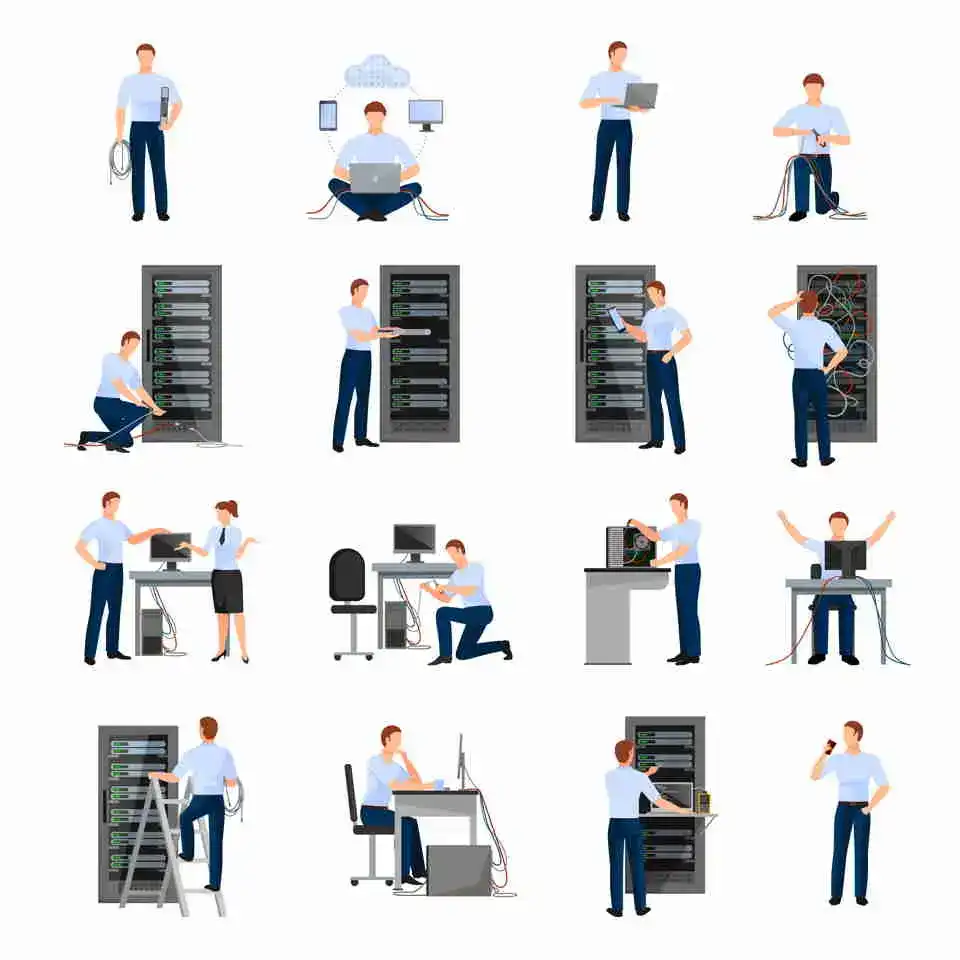 Maintenance
Maintenance
We’ve briefly touched upon network maintenance considerations in the previous section when discussing the need for 24/7 access to relay sites and fibre locations. Of course, this only managed to scratch the surface of this quite complex topic. (Photo credit: Macrovector/Shutterstock)
Let’s look at a few other key points to do with network maintenance:
- Keeping track of customer issues
Soon after you’ve connected your first customers, calls will start coming in signalling various issues. In order to keep track of all these and ensure that they are dealt with in a timely manner, you should use some sort of ticketing software.
- Dealing with billing
Keeping up with billing is also something you can do using a helpful piece of software. Choose one that will automatically deal with issues such as late payments.
- Network management
In order to keep your lines from being inundated with calls from customers whenever there is an outage, you should again opt for a specialised piece of software. A network management suite will track your network and alert you as soon as problems come up. An advanced one will even be able to veer your attention towards parts of your network which need upgrading, thus allowing you to pre-empt outages and other issues.
Undertaking physical maintenance works is highly dependent on your particular circumstances. You should, however, have a clear plan of how to deal with these issues from the very moment your network goes online.
Ensuring a Bright, Secure, and Private Future for the Internet
Currently, the UK lags behind most of the developed world in terms of broadband speeds. Comparing the 97% of connections with full fibre lines in Japan to the UK’s 3% is telling enough. The rural areas in the UK which are most affected by the technological divide will obviously have the most to benefit from community-led broadband projects. It’s estimated that about 17% of rural homes aren’t receiving satisfactory internet, compared with only 2% in cities and towns.
What’s more, those in cities and towns can benefit from this too – local neighbourhood networks, be they WiFi or fibre, can put an end to widespread customer dissatisfaction as well as more significant issues to do with privacy.
The Investigatory Powers Act 2016 requires ISPs to store detailed internet usage logs such as websites visited, files downloaded, and software used for all customers. Before the Act came into law, ISPs would only be allowed to log their customer’s online activity for up to 12 months after a warrant was presented to them. Furthermore, the information stored would be represented by metadata – a much more basic and undetailed form of data compared to the internet connection records mentioned in the IPA 2016.
Even if you trust the executive to not abuse the powers given to it by this Act, the fact that such logs are stored by your ISP makes them potentially vulnerable to cyberattacks. The private detailed logs of millions of internet users could be compromised and made public during such an attack.
With the growing recognition of just how valuable information of this sort is, it could be especially lucrative for hackers to steal the data contained in ISP databases, selling these logs on for hefty sums. US legislation can offer up some clues as to how large the market for such figures actually is, so can the recent Facebook Cambridge Analytica scandal.
Online privacy, better service, higher speeds – it’s time to build our own internet!

